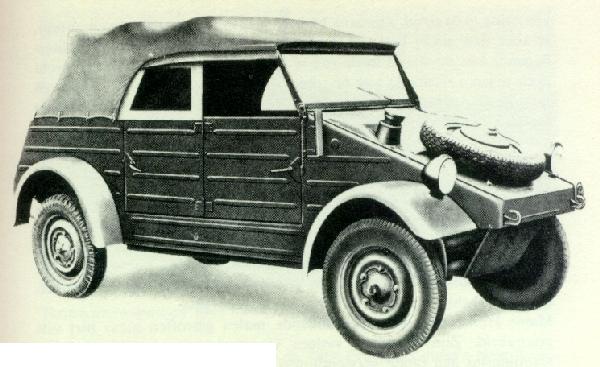
But it was not until 1969 that a contemporary version of the type 82 went in production: the Typ 181 (right).

Then in 1954, the newly formed German
Bundeswehr
(Federal Army) invited the German car industry to submit pilot models for
the new Army's
Lkw 0,25 t gl (Lastkraftwagen, 0,25 ton, geländegängig,
or: truck, 1/4-ton, off-road capable). As the Bundeswehr would have liked
to procure a further-developed variant of the Type 82 Kübelwagen,
Volkswagen was also approached to get involved. But Dr. Heinz Nordhoff
could not really be interested in what - for VW - was a small-scale production
of four wheel drive field cars: they had their hands full on civil car
production.
Eventually, Auto Union's DKW Munga
was selected, of which the Bundeswehr procured about 28,400 out of a total
of 46,750 built between 1956 to 1968.
In the 1960s France, West Germany and Italy started a joint project for a new 500 kg (4x4) amphibious vehicle which became known as the Europa Jeep. Awaiting the arrival of this vehicle the Bundeswehr decided to procure a stop-gap vehicle to replace the DKW Munga, which was really getting outdated near the end of the 1960s. This time VW could be interested to build a vehicle, and from 1969 they built 15,200 VW 181s for the Bundeswehr as a temporary substitute. It was largely based on commercial VW vehicles to keep development and production costs down. This resulted in what was in effect a contemporary version of the WW-2 type 82. As the original it had rear wheel drive only (with optional self-locking differential) because of which it had a limited off-road capability. It was however, perfect for liaison duties etc. and was classed as a Mehrzweckwagen (multi-purpose vehicle). In 1976 the 'Europa-Jeep' project was finally cancelled, and VW got an order for 8,800 4x4 vehicles with a cargo capacity of 500 kg both on and off roads: the VW 183 Lkw 0,5 t gl, alias Iltis.
The type 181's rated payload for
military use was 400 kg, and being a general utility vehicle, its uses
included command, patrol, dispatch and radio vehicle. Standard military
equipment included an axe, headlamp blackout covers, military lighting
system, map light, radio suppression, four rifle mounts, spade, starting
handle, towing eye, towing hook and a wheel chock. Radio vehicles had an
additional 24V, 756 Watt dynamo fitted.
Once VW had tooled up for this utility
vehicle, efforts were made to sell it to other military users as well.
These included the armies of Austria (Bundesheer, federal army), Belgium,
Denmark, France (units stationed in Germany), Morocco, The Netherlands
(Luchtmacht, air force). Since 1981 more than 9,000 German Bundeswehr type
181s were struck off charge by the German government, being sold on the
open market as well as being donated to the Greek and Turkish army. In
1992 an estimated maximum of 4,000 type 181s were still in service with
the Bundeswehr.
An effort was made to sell the type
181 on the private market also. In Europe, it was labelled as a vehicle
for forestry services, hunting, etc. and simply named VW 181. In sunnier
climates it was marketed as a fun vehicle: in the USA, it was sold as the
THING (including an 'Acapulco' version), in Mexico as the Safari. Even
a right-hand drive version, The Trekker, was built for the UK market.
All VW 181s were basically the same,
differences being made in lightning, emission controls etc. to comply to
local regulations. The biggest change was made in the 1974 model year,
when the rear axle lay-out was changed: the swing-axle transmission was
replaced by one with double-jointed axles with constant-velocity joints.
Between 1969 and 1972 the VW 181
was produced in Germany. From 1973 until 1980 production took place in
Mexico, kits also being assembled in Indonesia. Sadly, information about
production figures is contradictive to say the least. Numbers range from
70,495 to almost the double at 140,768. One thing is sure: VW sold more
of them than they ever hoped for!
(*) "Typ"
means "type" in German - nouns are written with capitals.
Source: Hanno Spoelstra
Last update: 30-08-2000
Copyright © 1996-2000 H.L. Spoelstra / All Rights Reserved